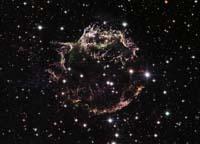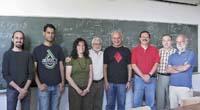2008/10/01
246. zenbakia

eu es fr en cat gl
Aparecerá un contenido traducido automáticamente. ¿Deseas continuar?
Un contenu traduit automatiquement apparaîtra. Voulez-vous continuer?
An automatically translated content item will be displayed. Do you want to continue?
Apareixerà un contingut traduït automàticament. Vols continuar?
Aparecerá un contido traducido automaticamente. ¿Desexas continuar?
Discovering the Oscurities of the Universe
Text created by automatic translator Elia and has not been subsequently revised by translators.
Elia Elhuyar
Although it can be thought that man knows a lot about the universe, there are still many phenomena to be solved. A group of cosmologists from the UPV seeks the model that best explains the development of the universe.
Discovering the Oscurities of the Universe
01/10/2008 | Ochoa de Eribe Agirre, Alaitz | Elhuyar Zientzia Komunikazioa

(Photo: ESA/J.R. Maund)
Scientists studying the universe represent them by looking from a telescope. And yes, that's what astrophysicists do: collecting data on phenomena that can be observed in the cosmos. But to interpret this data, that is, to explain most of the phenomena that occur in the universe, it is necessary to perform complex computer calculations that are based on suitable mathematical models. This is the work of the research team Gravitation and Cosmology of the UPV/EHU in the study of models that serve to explain the development of the cosmos.
Supernovas, witness of acceleration
One of the phenomena that the Standard Model of Cosmology has not yet explained is the accelerated expansion of the universe. Although Einstein proposed a static model to describe the cosmos, today it is known to be spreading. Among other things thanks to the supernovae. Supernovae are a very bright stellar explosion and are therefore so useful to see the remote parts of the cosmos. The measure of the amount of light that comes to us from the supernovae allows us to know the distance to which they are and estimate by their color the speed to which they are moving away. And the more reddish it is, the faster they move away from us. That is, if we compare two supernovae, the one that moves away at the slower speed will have a more blue color and the one that moves away faster, more reddish. Astrophysicists have seen that supernovae, in addition to moving away, are moving away faster and faster, that is, moving away at accelerated speed, with all other matter of the universe.
Looking for dark energy
But the known energy in the universe is not enough to cause that acceleration. Therefore, the most widespread thing in the scientific community is that there is a "dark energy", that is, if it were not for the gravitational force it generates, we could not detect. It is estimated that 73% of the total energy of Cosmos is dark. Dark energy is not any debate: it cannot be shown to exist, but without it the Standard Model of Cosmology could not explain many of the phenomena that occur in the universe.
And… what is dark energy? What features do you have? Have these characteristics always been the same or have they been changing over time? These questions are intended to be answered by these researchers from the UPV Faculty of Science and Technology, led by Dr. Alexander Feinstein.

The color of the supernovae allows you to calculate the speed at which you are moving away.
Recent searches
The only known characteristic of dark energy is its distancing gravitational force. That is, unlike the gravitation we know, this force tends to distance itself between galaxies, stars and other structures of the universe. This would explain why the expansion of the cosmos is not constant, but accelerated. However, this phenomenon can only be detected by reaching very high observation distances. That is why it is so difficult to understand and explain dark energy.
Ghostly Energy Theory
How far can the universe expand? If that distant gravitational force is ever stronger… can it become infinite? This is one of the topics studied by UPV researchers. This dark energy, so strong, is known as phantom energy. By its influence the cosmos can spread so much, where known structures can be destroyed.
This group of researchers believes that the most appropriate model for explaining the accelerated expansion of the universe can be phantom energy. This is due, among other things, to the microwave background radiation that has spread throughout the cosmos since the Big Bang and to the study of galaxy distribution. These waves propagate in all directions and allow to analyze very ancient facts, close to the beginning of everything.
Summary:
It is a matter of explaining from a theoretical perspective the influence of the main components of the universe in its evolution.
Director:
Alexander Feinstein.
Working team:
Juan María Aguirregabiria, Martín Rivas, Jesús Ibáñez, Raül Vera, Alberto Díez-Tejedor, José M. Martín-Senovilla, Ruth Lazkoz, Guillermo González and Alberto Chamorro.
Department:
Theoretical Physics and History of Science.
Faculty:
Faculty of Science and Technology.
Financing:
Basque Government, MEC.
Website
Related links

On the left, Raül Vera, Alberto Díez-Tejedor, Ruth Lazkoz, Alberto Chamorro, Alexander Feinstein, Guillermo González, Juan María Aguirregabiria and Martín Rivas. Missing: José María Martín Senovilla and Jesús Ibáñez.
(Photo: A. Ochoa de Eribe)
Ochoa by Eribe Agirre, Alaitz
Services
246
2008
Services
035
Astrophysics; Universities
Dissemination of knowledge
Other








